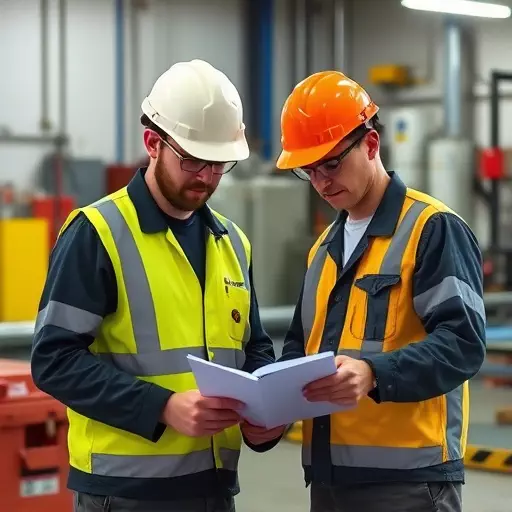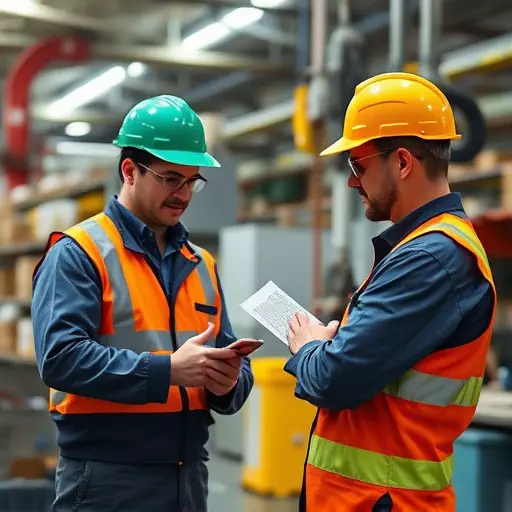Industrial hygiene consultants play a vital role in managing workplace hazards through comprehensive chemical exposure assessments. They employ air sampling, risk assessment tools, and toxicology analyses to evaluate substance levels, compare them against occupational exposure limits (OELs), and recommend safety strategies. These evaluations guide the implementation of controls like ventilation or PPE, ensuring worker well-being, preventing health issues, and maintaining regulatory compliance. Regular workplace hazard evaluations by these experts are essential for identifying and mitigating chemical risks in various industries.
“Uncovering risks hidden in plain sight: An in-depth exploration of chemical exposure assessment. This comprehensive guide arms industrial hygiene consultants with essential tools for navigating complex chemical hazards in the workplace. From laying the foundation through understanding exposure assessment principles to delving into best practices, we uncover how workplace hazard evaluations can identify and mitigate risks effectively. Furthermore, we demystify occupational exposure limits, ensuring safe work environments that protect employees from harmful substances.”
- Understanding Chemical Exposure Assessment: A Foundation for Industrial Hygiene Consultants
- The Role of Workplace Hazard Evaluation in Identifying and Mitigating Risks
- Navigating Occupational Exposure Limits: Ensuring Safe Work Environments
- Best Practices for Comprehensive Chemical Exposure Assessment by Industry Experts
Understanding Chemical Exposure Assessment: A Foundation for Industrial Hygiene Consultants

Chemical exposure assessment is a critical component of industrial hygiene, serving as the foundation for managing workplace hazards effectively. It involves identifying, evaluating, and understanding chemical substances present in a work environment to determine potential risks and ensure worker safety. Industrial hygiene consultants play a pivotal role here, as they possess the expertise to conduct thorough assessments tailored to specific industries and jobs.
These professionals use various methods, including air sampling, biologic monitoring, and risk assessment tools, to determine exposure levels and compare them against occupational exposure limits (OELs). By analyzing these data, consultants can recommend strategies to reduce or eliminate hazards, ensuring compliance with regulations while prioritizing worker health and well-being. This proactive approach is essential in mitigating the potential consequences of chemical exposure, which can range from acute injuries to chronic health conditions.
The Role of Workplace Hazard Evaluation in Identifying and Mitigating Risks

Workplace Hazard Evaluation plays a pivotal role in identifying and mitigating risks associated with chemical exposure. Conducted by industrial hygiene consultants, this process involves assessing the work environment to understand the types and levels of chemicals present, as well as evaluating the potential health effects on workers. By thoroughly examining tasks, processes, and control measures already in place, these evaluations help identify sources of chemical exposure and guide the implementation of appropriate controls, such as engineering controls, administrative procedures, or personal protective equipment (PPE).
The outcome of a workplace hazard evaluation is crucial for establishing meaningful occupational exposure limits. These limits, set by regulatory bodies, define safe levels of chemical exposure in the workplace. By aligning with these guidelines, organizations can ensure that their operations do not put employees at risk for health issues stemming from chemical exposure. Regular assessments also facilitate ongoing monitoring and surveillance, enabling businesses to take proactive steps towards maintaining a safe and healthy work environment.
Navigating Occupational Exposure Limits: Ensuring Safe Work Environments

Navigating Occupational Exposure Limits plays a crucial role in ensuring safe work environments. Industrial hygiene consultants emphasize that understanding and adhering to these limits is vital for preventing workplace hazards. Occupational exposure limits (OELs) are established by regulatory bodies based on scientific studies to protect workers from potential health risks associated with specific chemicals. These limits provide guidelines for acceptable concentrations of substances in the air over a certain period, ensuring that employees’ cumulative exposure stays below levels known to cause harm.
Regular workplace hazard evaluations conducted by experts help identify and mitigate risks associated with chemical exposures. By assessing factors like the toxicology of the substance, duration of exposure, and tasks performed, industrial hygiene consultants can recommend appropriate control measures. This may include implementing engineering controls, such as ventilation systems, or using personal protective equipment (PPE) to minimize employee contact with hazardous chemicals. Staying within OELs not only protects workers’ health but also fosters a culture of safety in the workplace.
Best Practices for Comprehensive Chemical Exposure Assessment by Industry Experts

When conducting a chemical exposure assessment, adhering to best practices is essential for accurate and comprehensive results. Industrial hygiene consultants recommend a multi-faceted approach that includes thorough workplace hazard evaluations. This involves identifying all potential sources of chemical exposure, characterizing their properties, and understanding how workers might come into contact with them. A systematic analysis of the work environment, job tasks, and employee activities is crucial to capture every possible route of exposure.
Furthermore, leveraging established occupational exposure limits (OELs) from reputable organizations provides a critical framework for comparison. These limits serve as guidelines to ensure that chemical concentrations in the workplace do not exceed safe levels. Regular monitoring and sampling are vital components of the assessment process, allowing for data-driven decisions on control measures. By combining these strategies, industrial hygiene consultants can deliver robust evaluations that prioritize worker safety and compliance with regulatory standards.


